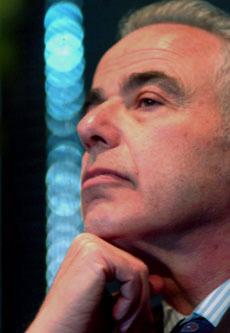Conference discusses diversity effects

April 24, 2006
The Center on Democracy in a Multiracial Society and the Ford Foundation hosted the first conference on “Documenting the Differences Racial and Ethnic Diversity Makes,” Friday. The all-day conference focused on the findings of the Freshman Diversity Project, that 185 faculty members, staff, administrators and students attended.
Chancellor Richard Herman announced that the conference will become a biannual event.
“Hopefully we’ll draw more from our community and other institutions . and garner our reputation for doing this program,” said Julia Johnson Connor, interim assistant director of the Center on Democracy in a Multiracial Society. “We’re managing to demonstrate diversity as a compelling interest.”
In 2003, the Supreme Court ruled that for 25 years, race can be considered in university admissions procedures to achieve a diverse student body. As a result, the Ford Foundation set aside money and called for proposals for scholars to document the effects of diversity at the University.
“There’s nothing more important than the dialogue we’re engaged in today,” Herman said at the closing session. “Diversity matters in the case that it shapes how we interact with one another . we still have a long road to travel down.”
Get The Daily Illini in your inbox!
Following Herman’s speech, a panel addressed different diversity issues that they believed were important. Several panelists discussed the number of minority faculty and students at the University.
William E. Berry, associate chancellor, says there are only 414 blacks of about 10,000 graduate students overall. There are 2,000 faculty members on campus, but only about 80-100 faculty of color.
“It’s a very complex mosaic. We’ve got to recruit these people. In a nutshell, it’s about how you get people here . and keep them here,” said Berry in his panel speech during the closing session.
Through the project and other reporting, William Trent, professor in educational policy studies, says the University should not preserve diversity, but promote it.
“When I think about our research universities . we want to be the place where scholars can work collaboratively in new ways and work on the problems our society needs us to work on,” said Barbara Allen, director of the Committee on Institutional Cooperation, during her presentation in the closing session. “Diversity has to be a part of the mosaic.”
Herman believes that diversity is a rising issue that must be addressed, and he is inviting the cultural centers and ethnic studies programs to incorporate their ideas into the strategic plan.
“We must work to ensure the goal of diversity is central to our . practices, teaching and learning,” Herman said. “(Our) University must take the lead in a national debate on alternative action.”
By Christine Kim
Staff writer
The Center on Democracy in a Multiracial Society and the Ford Foundation hosted the first conference on “Documenting the Differences Racial and Ethnic Diversity Makes,” Friday. The all-day conference focused on the findings of the Freshman Diversity Project, that 185 faculty members, staff, administrators and students attended.
Chancellor Richard Herman announced that the conference will become a biannual event.
“Hopefully we’ll draw more from our community and other institutions . and garner our reputation for doing this program,” said Julia Johnson Connor, interim assistant director of the Center on Democracy in a Multiracial Society. “We’re managing to demonstrate diversity as a compelling interest.”
In 2003, the Supreme Court ruled that for 25 years, race can be considered in university admissions procedures to achieve a diverse student body. As a result, the Ford Foundation set aside money and called for proposals for scholars to document the effects of diversity at the University.
“There’s nothing more important than the dialogue we’re engaged in today,” Herman said at the closing session. “Diversity matters in the case that it shapes how we interact with one another . we still have a long road to travel down.”
Following Herman’s speech, a panel addressed different diversity issues that they believed were important. Several panelists discussed the number of minority faculty and students at the University.
William E. Berry, associate chancellor, says there are only 414 blacks of about 10,000 graduate students overall. There are 2,000 faculty members on campus, but only about 80-100 faculty of color.
“It’s a very complex mosaic. We’ve got to recruit these people. In a nutshell, it’s about how you get people here . and keep them here,” said Berry in his panel speech during the closing session.
Through the project and other reporting, William Trent, professor in educational policy studies, says the University should not preserve diversity, but promote it.
“When I think about our research universities . we want to be the place where scholars can work collaboratively in new ways and work on the problems our society needs us to work on,” said Barbara Allen, director of the Committee on Institutional Cooperation, during her presentation in the closing session. “Diversity has to be a part of the mosaic.”
Herman believes that diversity is a rising issue that must be addressed, and he is inviting the cultural centers and ethnic studies programs to incorporate their ideas into the strategic plan.
“We must work to ensure the goal of diversity is central to our . practices, teaching and learning,” Herman said. “(Our) University must take the lead in a national debate on alternative action.”






